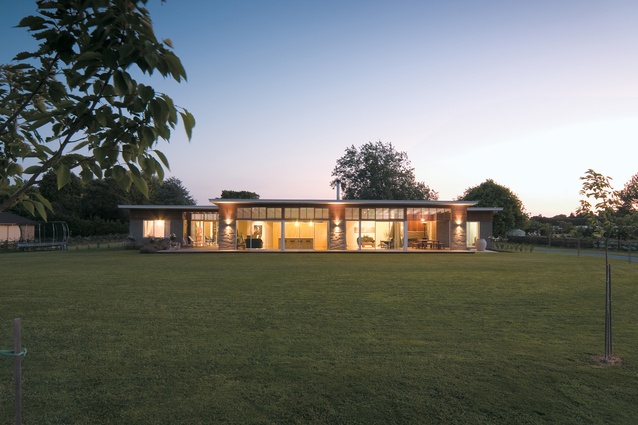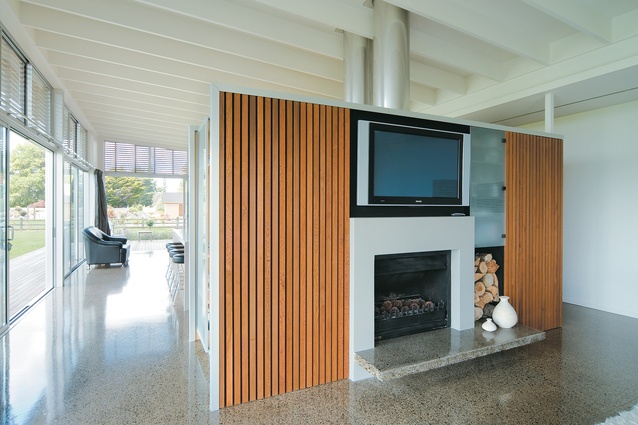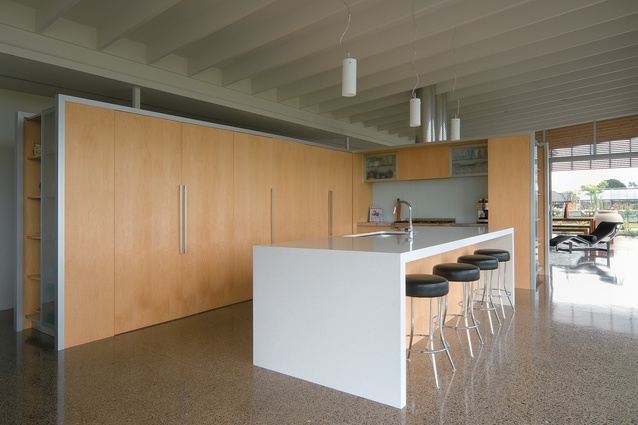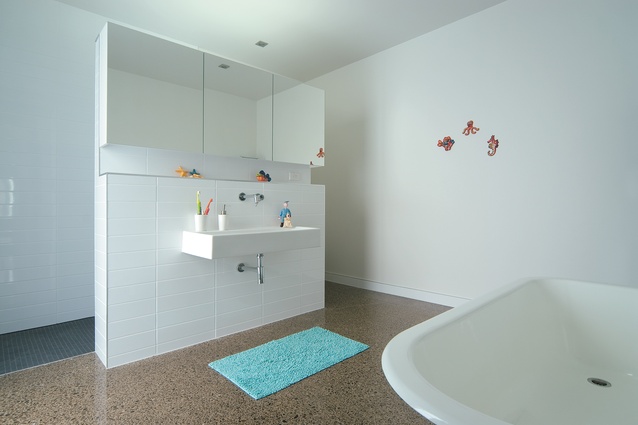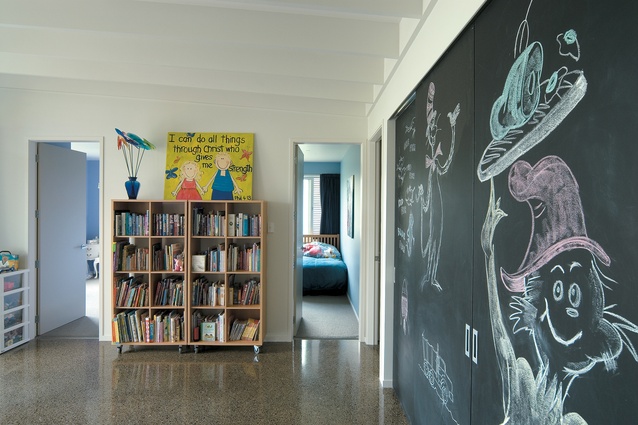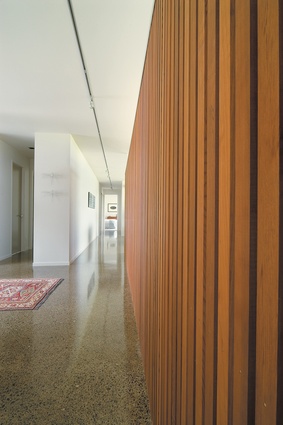Houses Revisited: Suburban values
With this project from 2008, Edwards White Architects creates a relaxed house in a Hamilton subdivision that is a model Kiwi family home.
Where the cows once roamed on the rural outskirts of Hamilton, the paddocks are now chocka with some rather incongruous and palatial McMansions in a new subdivision. But among them is this house, designed for his family by Grant Edwards of Edwards White Architects, a quiet and unpretentious addition to the landscape. With its simple form and low mono-pitched roof, it reminds me of some classic Vernon Brown houses from the 1940s that were themselves inspired by vernacular buildings such as dairy sheds.
I can see that the gentlefolk of the Waikato may aspire to go home to something at night that’s not reminiscent of the day’s work but this is a deceptively simple house that does a great job of housing a family as well as integrating a lot of sustainable features into the design. Sustainable is the buzzword these days but it is surprising how a little extra attention and expense can make a big, positive difference to both the longer-term cost and quality of living, not to mention offering a bit of environmental benefit too.
Not that the size of these sections would meet the approval of the green star box-tickers, but it is rather nice to settle in a suburb where the sections are big and open and the family can relax. Otherwise, what is the Kiwi suburb for? The driveway loops around a big lawn to an entry courtyard at the back, defined by the L-shaped form of the house and a large and beautiful plane tree. The short end of this wing – home office, garage and laundry – creates an area, sheltered from the elements, where the kids and junk and stuff of family life can spread out.
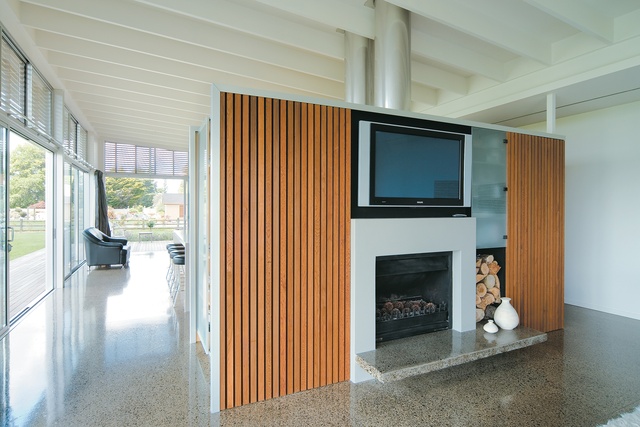
The main body of the house is one long relaxed length sheltered by a big simple roof, with kids at one end, adults at the other and kitchen in the centre. The east and west ends each open onto a sheltered courtyard space so there is always one outdoor spot that’s out of the breeze and sunny, or the opposite if you like. There is a lot of glass along this north-facing front and while the roof overhang doesn’t look as though it would offer much protection, it is carefully calibrated to the varying height of the sun in summer and winter. In summer when the sun is high, the eave shades the windows, but in winter when the sun is low, it warms the interior space and the polished concrete floor soaks up heat. When the temperature drops at night and you pull the curtains, the concrete radiates this heat back into your living space. Double-glazing helps.
Concrete has a reputation as cold in this country because we don’t let sunlight get at it. In fact, it has great thermal capacity and is good at storing warmth or ‘coolth’. This is one of the simplest tenets of passive solar heating and cooling and is very easy to achieve, and it’ll save you a fortune. This house has under-floor heating as well but the inhabitants never have to use it because the architect got the basics right.
The exterior cladding is unpainted bagged brick and the timber slats that run around the top of the house aren’t just there for aesthetics either, though they do well to tie the house together. They form a screen that conceals opening windows allowing ventilation without compromising security. This screen also provides a sense of containment and shelter, a nice ‘nesty’ feeling. It’s good to see a house unafraid of texture after the last decade’s run of minimal glass boxes.
Although minimalism doesn’t preclude materiality, here the uneven bagged brick, the exposed rafters and the natural timber give the house a slightly earthy, rustic quality appropriate to its location in the country. This is something its neighbours, who have caught the Auckland stucco disease, don’t have. The slats continue inside and line a couple of freestanding walls to provide acoustic benefits and also form concealed cupboards for paraphernalia of the electronic kind.
The interior is one long space divided into living and kitchen/dining areas by these freestanding walls. They preserve a nice sense of a shared internal space with the roofline’s rhythm of exposed rafters flowing through, but preserve visual privacy. With parents and guests at one end of the house and kids at the other, separated by a kind of close-off-able anteroom-cum-play room, it’s a house that celebrates togetherness but also gives everyone the space and privacy they need. The kitchen is right in the centre of the house, between the two living areas. It’s a cool freestanding pod, but big enough to open up and serve a big family, and also, in a central location like this, has enough in the way of doors to shut up shop in a flash and hide everything away.

Now, as an Aucklander, I did think the big sprawling section this house reclines on had a bit too much of a carbon footprint, but a good size section does allow enough space for on-site collection and disposal or re-use of waste and water. This house collects just about all the water it needs off its roof. The water is stored in an underground tank and an aerated version of the old septic tank deals with all the sewage in such an efficient way that you can use it to water your garden as well.
This is a big house on a big section but it’s not super expensive. Not everyone could afford to build like this, nor could we afford for everyone to live like this. But for middle-class Kiwis like me who have grown up in the suburbs in a decent-sized house with a decent-sized lawn, and would like to raise our families the same way, in what is, after all, a fairly sparsely populated and well-off land, it’s a model New Zealand house for the future. It suggests we might be able to maintain our lifestyle but also incorporate sufficient sustainable features that we could just about get off the grid. This is a New Zealand house that is a relaxed and spread-out family home, with a really simple and coherent design very well related to its place in the landscape and ecosystem.
Click here to see more Houses Revisited. And sign up to our email newsletters to receive Houses Revisited straight to your inbox.
Note: Since the time of writing, the architecture firm mentioned may have changed personnel, name or both.

